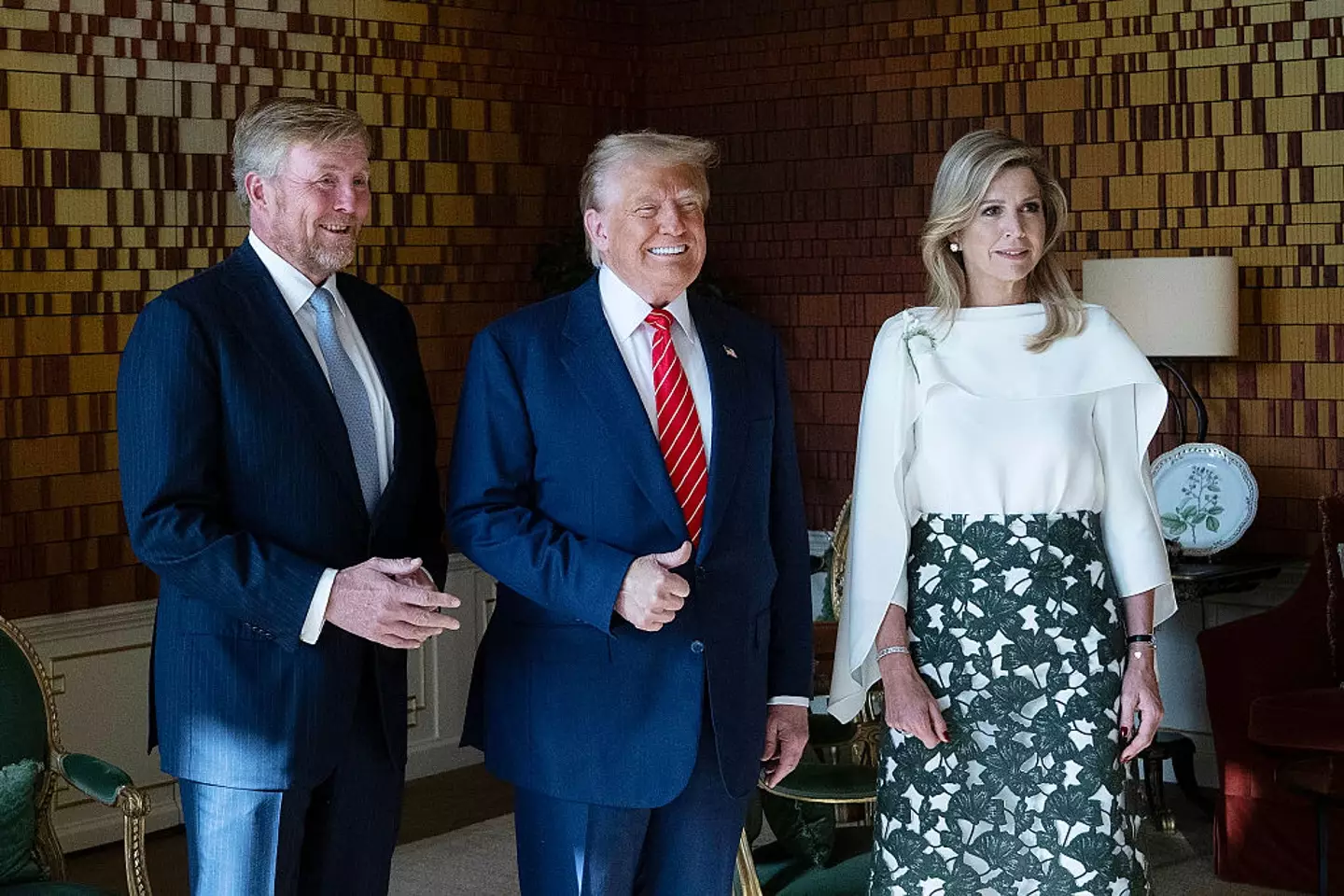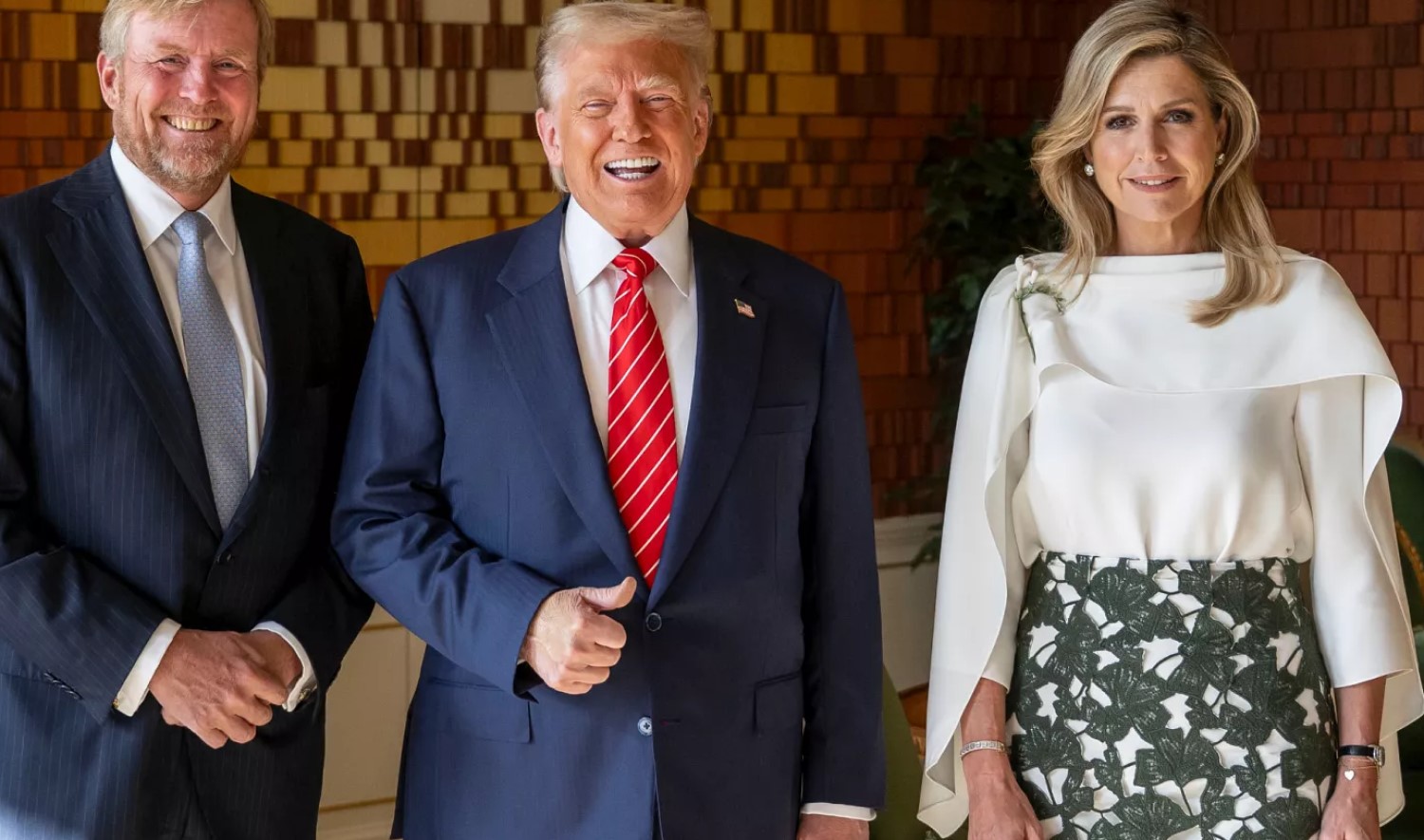Amid the grandeur and high-stakes diplomacy of the NATO summit held in The Hague, a quieter, unexpected moment managed to steal the spotlight from the formalities and strategic discussions. With world leaders gathered to address pressing global issues, all eyes momentarily turned to a brief yet captivating interaction between Queen Maxima of the Netherlands and former U.S. President Donald Trump. The incident, subtle in nature but explosive in interpretation, has sparked intense debate online and across global media.
As cameras rolled and shutters clicked, the choreography of diplomacy unfolded. President Trump, on his European visit for the summit, made a formal stop at Huis ten Bosch Palace where he met with King Willem-Alexander and Queen Maxima. The official photo op that followed was meant to be a ceremonial exchange, standard fare during such international visits. However, it became something far more controversial.
A Seemingly Harmless Moment Turned Internet Sensation
Footage from the royal palace quickly began circulating, showing President Trump smiling broadly and giving his signature thumbs-up gesture to the assembled press. Queen Maxima stood alongside him, composed and elegant as always. But it was what happened seconds after Trump spoke that lit up social media.
In a split-second moment, Queen Maxima appears to subtly mimic or exaggerate the movement of Trump’s mouth after he says “thank you.” Whether it was intended to be humorous, sardonic, or merely instinctive remains the subject of rampant speculation. Following the mimicry, she glanced directly at a nearby camera in what many have dubbed a “The Office-style” fourth wall break. The moment was fleeting, but its impact was immediate.

The trio posed for photos together (Brendan Smialowski – Pool/Getty Images)
Viewers online were quick to react. “Queen Maxima mimicking Trump’s mouth movements really got me,” one user posted, while another remarked, “Poor lady just got herself an entire Truth Social post.”
The Public Reacts: From Hilarious to Horrified
Within hours, thousands of people weighed in with interpretations ranging from amused admiration to sharp criticism. Some saw the queen’s action as a rare glimpse of authentic royal personality—an unscripted, humorous moment that humanized her. Others viewed it as a breach of royal decorum and diplomatic respect.
“WAIT A MINUTE WAS QUEEN MAXIMA OF THE NETHERLANDS MIMICKING DONAL TRUMP?” wrote one incredulous user. Another claimed, “I’ve never been a fan of our stiff monarchy, but Queen Maxima rocks it! Treat him like a baby.”
Critics, however, didn’t find the moment so lighthearted. One viewer blasted the queen for behaving in a manner they called “unprofessional & b*tchy,” arguing that it reflected poorly not only on her personal conduct but on the Netherlands as a whole.
Royal Protocol vs. Personal Expression
Queen Maxima has long been admired for her charisma, modern sensibility, and approachable demeanor—traits that set her apart from some of her more reserved European royal counterparts. However, being a public figure in such a symbolic position also means her every gesture is scrutinized, especially in interactions with figures like Trump, who evoke strong global reactions.
The monarchy traditionally embodies a code of neutrality, dignity, and restraint. Departures from this code, even if subtle or unintended, are often dissected for political and diplomatic implications. Whether or not Queen Maxima’s facial movement was a moment of jest, frustration, or involuntary reaction is difficult to determine, but the discourse it generated reflects broader divisions in how people interpret royal behavior.
Media Analysis: The Body Language Debate
Adding fuel to the fire, body language expert Darren Stanton analyzed the now-famous photos and video. Speaking on behalf of Genting Casino, Stanton noted:
“The photo of Trump, the King, and Queen Maxima shows the Queen to be the more dominant of the two Dutch royals. The King can be seen looking ahead with the same self-soothing gesture, covering his abdomen, but the Queen is turned directly to Trump and mirroring his gestures—almost trying to assert her own dominance.”
Stanton’s analysis added a layer of interpretation that transcended the moment itself. Was Queen Maxima consciously controlling the dynamic? Was she sending a message? Or was this, as some have claimed, simply an unguarded moment of levity?
The Context: A Politically Charged Visit
President Trump’s visit to the Netherlands was already politically charged. Dubbed by some European officials as a “testing ground for NATO unity,” the 2025 summit was marked by pointed discussions about defense contributions, Eastern European security, and transatlantic cooperation. Trump’s often contentious stance on NATO’s financial structure and his prior criticisms of European defense spending created an atmosphere of tension.
Against this backdrop, any perceived slight—from a facial expression to a misinterpreted comment—was likely to draw attention. The media’s hyperfocus on body language, gestures, and off-the-cuff remarks underscores how diplomacy in the 21st century is as much about perception as policy.
Gender, Power, and Public Perception
The incident has also opened up discussions about gender roles and power dynamics in global politics. Queen Maxima, a woman in a traditionally male-dominated space, stood not only beside a former U.S. president but also in front of an international audience hungry for symbolism. In this context, even the subtlest act—whether interpreted as parody, resistance, or empowerment—can take on oversized meaning.
Supporters have framed the moment as an emblem of female strength and quiet rebellion against patriarchal norms. Detractors argue that it crosses the line from diplomacy into disrespect.
Cultural Differences and Diplomatic Decorum
It’s also worth noting the cultural context in which this interaction took place. Dutch culture is known for its directness and pragmatism. In the Netherlands, humor and frankness are often valued over excessive formality, especially in informal settings. This cultural lens may offer an alternative explanation for Queen Maxima’s behavior—one that sees it as reflective of personality rather than calculated insult.
Yet, international diplomacy operates on a different wavelength. Royal families, particularly during high-profile international events, are expected to maintain a posture of impeccable neutrality and tact. In that light, even a subtle smirk or glance can carry diplomatic consequences.
The Media’s Role: Magnifier or Mirror?
Media coverage has amplified the moment, dissecting it frame by frame. The 24/7 news cycle and the viral nature of social media ensure that even the most fleeting gesture can dominate headlines for days. This reality raises important questions about how political figures and royals alike navigate public visibility in an age where every movement is recorded, scrutinized, and memed.
The video, still circulating widely, has prompted editorials, reaction videos, and even parody TikToks, further embedding the moment into pop-cultural consciousness. Whether this coverage has been fair or hyperbolic is up for debate—but what’s certain is that the media machine has made the moment unforgettable.
Silence from the Royal Household
As of now, the Royal Press Office has not released a formal comment. The decision to remain silent may be strategic, allowing the storm to pass without escalating the situation. Silence in royal circles often serves as a shield—a way to maintain dignity without feeding controversy.
It’s also worth mentioning that President Trump himself has not commented publicly on the interaction. While many anticipated a fiery Truth Social post, no such message has emerged, possibly indicating a conscious decision to downplay the incident or focus on larger strategic goals.
Historical Echoes: Royals and Political Faux Pas
This isn’t the first time a royal has found themselves at the center of a political kerfuffle. From Princess Diana’s subtle defiance to Queen Elizabeth II’s carefully timed wardrobe choices, royal figures have often made headlines for gestures that seem to carry hidden messages.
In that context, Queen Maxima’s micro-expression—intentional or not—fits within a broader pattern of royal figures navigating modern media scrutiny while preserving their symbolic roles.
What This Moment Reveals
Beyond the media frenzy and partisan interpretations, the moment offers a window into the evolving nature of global diplomacy. It highlights the precarious tightrope that public figures—especially royals—must walk in an era of omnipresent cameras and immediate public feedback.
It also reveals the enduring tension between authenticity and protocol. In a world where diplomacy often feels staged and inaccessible, a single relatable expression can capture the public’s imagination—even as it challenges established norms.
Final Reflections: An Iconic Moment or a Misunderstood Glance?
Whether Queen Maxima’s moment was an intentional parody, a spontaneous slip, or something in between, it has undeniably become part of the broader narrative of this year’s NATO summit. It reminds us that in international politics, not all defining moments happen behind closed doors. Sometimes, they unfold in front of a camera—in a glance, a smile, or the twitch of a lip.
As the world continues to digest the outcome of the summit, and as historians one day piece together the informal moments that shaped it, this brief interaction will likely be remembered—not just for what was said, but for what was subtly implied.
One thing is certain: in the age of digital diplomacy, no gesture is too small to matter.

